Pals1 - Study guides, Class notes & Summaries
Looking for the best study guides, study notes and summaries about Pals1? On this page you'll find 21 study documents about Pals1.
All 21 results
Sort by
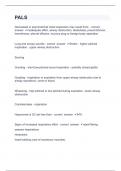
-
PALS1 Questions with complete solution
- Exam (elaborations) • 27 pages • 2024
- Available in package deal
-
- $14.49
- + learn more
PALS1 Questions with complete solution PALS Decreased or asymmetrical chest expansion may result from: - correct answer inadequate effort, airway obstruction, atelectasis, pneumothorax, hemothorax, pleural effusion, mucous plug or foreign-body aspiration Lung and airway sounds - correct answer Stridor - higher pitched inspiration...upper airway obstruction Snoring Grunting - short,low-pitched sound expiration - partially closed glottis Gurgling - inspiration or expiration from...
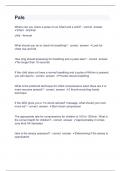
-
Pals1 Question and answers 100% correct
- Exam (elaborations) • 35 pages • 2024
- Available in package deal
-
- $13.99
- + learn more
Pals1 Question and answers 100% correct Pals Where can you check a pulse on an infant and a child? - correct answer infant - brachial child - femoral What should you do to check for breathing? - correct answer Look for chest rise and fall. How long should assessing for breathing and a pulse take? - correct answer No longer than 10 seconds If the child does not have a normal breathing and a pulse of 64/min is present, you will need to - correct answer Provide rescue breathing...
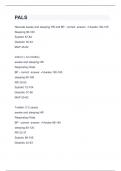
-
PALS1 Question and answers verified to pass
- Exam (elaborations) • 18 pages • 2024
- Available in package deal
-
- $13.99
- + learn more
PALS1 Question and answers verified to pass PALS Neonate awake and sleeping HR and BP - correct answer Awake 100-125 Sleeping 90-160 Systolic 67-84 Diastolic 35-53 MAP 45-60 Infant (1-12 months) awake and sleeping HR Respiratory Rate BP - correct answer Awake 100-180 sleeping 90-160 RR 30-53 Systolic 72-104 Diastolic 37-56 MAP 50-62 Toddler (1-2 years) awake and sleeping HR Respiratory Rate BP - correct ans
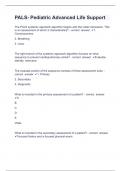
-
PALS1 Question and answers verified to pass
- Exam (elaborations) • 16 pages • 2024
- Available in package deal
-
- $14.49
- + learn more
PALS1 Question and answers verified to pass PALS- Pediatric Advanced Life Support The PALS systemic approach algorithm begins with the initial impression. This is an assessment of which 3 characteristics? - correct answer 1. Consciousness 2. Breathing 3. Color The right branch of the systemic approach algorithm focuses on what sequence to prevent cardiopulmonary arrest? - correct answer Evaluate, Identify, Intervene The evaluate portion of the sequence consists of three assessmen...

-
PALS1 Question and answers 100% correct
- Exam (elaborations) • 10 pages • 2024
- Available in package deal
-
- $14.49
- + learn more
PALS1 Question and answers 100% correct PALS What is the normal Heart Rate for a newborn to 3 month old baby? - correct answer 85-205 while awake (140) What is the normal Heart Rate for a 3 month old baby to a 2 year old child? - correct answer 100-190 while awake (130) What is the normal Heart Rate for a 2 year old child to a 10 year old child? - correct answer 60-140 while awake (80) What is the normal Heart Rate for a child older than 10 years of age? - correct answer 60-...
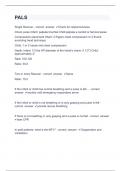
-
PALS1 Question and answer 100% correct
- Exam (elaborations) • 11 pages • 2024
- Available in package deal
-
- $13.49
- + learn more
PALS1 Question and answer 100% correct PALS Single Rescuer - correct answer Check for responsiveness Check pulse Infant: palpate brachial Child:palpate a carotid or femoral pulse Compression placement Infant: 2 fingers chest compression or 2 thumb encircling hand technique. Child: 1 or 2 hands mid chest compression Depth: Infant: 1/3 the AP diameter of the infant's check (1 1/2") Child: approximately 2" Rate: 100-120 Ratio: 30:2 Two or more Rescuer - correct answer Same R...
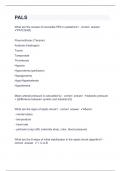
-
PALS1 Question and answers correctly solved
- Exam (elaborations) • 10 pages • 2024
- Available in package deal
-
- $14.99
- + learn more
PALS1 Question and answers correctly solved PALS What are the causes of reversible PEA in pediatrics? - correct answer PAT(3)H(5) Pneumothorax (Tension) Acidosis (Hydrogen) Toxins Tamponade Thrombosis Hypoxia Hypovolemia (perfusion) Hypoglycemia Hypo/Hyperkalemia Hypothermia Mean arterial pressure is calculated by - correct answer diastolic pressure + [(difference between systolic and diastolic)/3] What are the signs of septic shock? - correct answer Altered - mental...
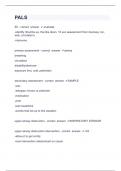
-
PALS1 Questions with complete solution
- Exam (elaborations) • 9 pages • 2024
- Available in package deal
-
- $15.49
- + learn more
PALS1 Questions with complete solution PALS In children most cardiac arrest results from what - correct answer progressive respiratory failure, shock or both What three things are you looking at during the inital impression? - correct answer Consciousness, Breathing, Color Levels of consciousness - correct answer Unresponsive, irritable, alert What could a flushed appearance suggest> - correct answer fever or presence of toxin You come upon a
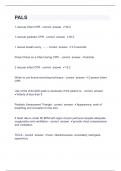
-
PALS1 Question and answers rated A+
- Exam (elaborations) • 9 pages • 2024
- Available in package deal
-
- $14.49
- + learn more
PALS1 Question and answers rated A+ PALS 1-rescuer infant CPR - correct answer 30:2 1-rescuer pediatric CPR - correct answer 30:2 1 rescue breath every ...... - correct answer 3-5 seconds Pulse Check on a infant during CPR: - correct answer brachial 2 rescuer infant CPR - correct answer 15:2 When to use thumb encircling technique - correct answer 2-person infant CPR Use of the child AED pads is necessary if the patient is: - correct answer Infants of less than ...
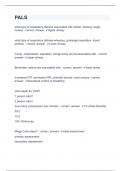
-
PALS1 Question and answers already passed
- Exam (elaborations) • 9 pages • 2024
- Available in package deal
-
- $13.99
- + learn more
PALS1 Question and answers already passed PALS what type of respiratory distress associated with stridor, barking cough, hoarse - correct answer Upper Airway what type of respiratory distress wheezes, prolonged expiration, tripod position - correct answer Lower Airway Croup, anaphalaxis, aspiration, foreign body are all associated with - correct answer upper airway Bronchitis, ashma are associated with - correct answer lower aiway Increased ICP, decreased RR, potenital to...

$6.50 for your textbook summary multiplied by 100 fellow students... Do the math: that's a lot of money! Don't be a thief of your own wallet and start uploading yours now. Discover all about earning on Stuvia


